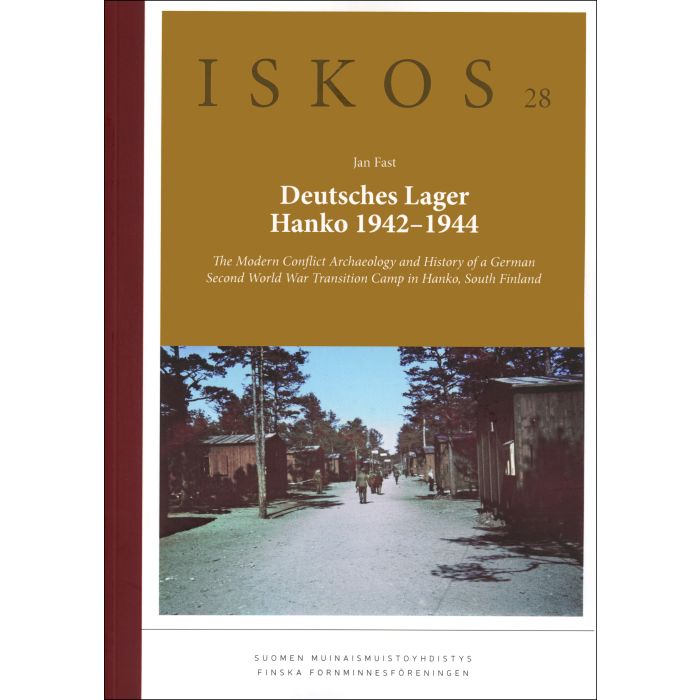Käytämme evästeitä parantaaksemme käyttäjäkokemustasi. Noudattaaksemme uutta sähköisen viestinnän yksityisyysdirektiiviä, meidän täytyy pyytää sinulta lupaa evästeiden asettamiseen. Lue lisää.
Deutsches Lager Hanko 1942-1944
20,00 €
Varastossa
SKU
978-952-6655-42-0
Fast, Jan
Deutsches Lager Hanko 1942-1944. The Modern Conflict Archaeology and History of a German Second World War Transition Camp in Hanko, South Finland
Suomen Muinaismuistoyhdistys
Iskos 28
Vaasa 2024, 261 pp.
Deutsches Lager Hanko 1942-1944. The Modern Conflict Archaeology and History of a German Second World War Transition Camp in Hanko, South Finland
Suomen Muinaismuistoyhdistys
Iskos 28
Vaasa 2024, 261 pp.
In the summer of 1942, construction of the large transition camp Deutsches Lager Hanko commenced on Cape Tulliniemi in south Finland. The camp was large for Finnish circumstances and built to facilitate the transports of the ever-growing number of German soldiers travelling on furlough between Finland and Germany.
Archival material on the German military presence in Hanko and the German transition camp on Cape Tulliniemi during the Second World War is virtually nonexistent. Multidisciplinary modern conflict archaeology can therefore play a vital role in trying to understand the history and make sense of the reality of life in the large camp. The diverse materiality of the camp provides clues and answers to questions such as how the camp was built, how waste disposal was organized and how the men and women in the camp lived and interacted with the surrounding nature and the townspeople of Hanko.
A broader and perhaps more creative approach than what is usually associated with archaeology is necessary for achieving an understanding and appreciation of extensive and complex Second World War sites like Deutsches Lager Hanko. This new approach includes a rethinking of the excavation and documentation methods used, as well as careful consideration when making decisions where the finds are kept for future generations and about what to conserve, preserve and not to preserve post excavation.
Finds like photographs, personal diaries, letters as well as lost artefacts related to the camp can be found on internet web auction sites, in estate sales and in personal collections all over the world. These finds help fill in the blank spots and explain the materiality found in the ground. The addition of photographic art research to modern conflict archaeology research facilitates the analysis of the finds and surviving structures of the camp by allowing them to be studied in close detail and from many different perspectives.
Modern conflict archaeology research of the German transition camp in Hanko increases the knowledge of and interest in the Second World War among the public, especially among schoolchildren. The excavation finds, which mostly consist of mundane everyday civilian artefacts, offer a new and almost totally overlooked glimpse into the materiality of the Second World War. The finds from the dumpsites of the camp bring humanity and the individual experience of war to the fore and provokes relevant discussions and thoughts about the role of ordinary humans caught up in a World War.
Second World War camp sites should be considered cultural heritage sites. They provide an important research and tourism potential for future generations and are part of the historical cultural landscape much in the same way as prehistoric dwelling sites and medieval villages or building foundations from the 18th century.
Archival material on the German military presence in Hanko and the German transition camp on Cape Tulliniemi during the Second World War is virtually nonexistent. Multidisciplinary modern conflict archaeology can therefore play a vital role in trying to understand the history and make sense of the reality of life in the large camp. The diverse materiality of the camp provides clues and answers to questions such as how the camp was built, how waste disposal was organized and how the men and women in the camp lived and interacted with the surrounding nature and the townspeople of Hanko.
A broader and perhaps more creative approach than what is usually associated with archaeology is necessary for achieving an understanding and appreciation of extensive and complex Second World War sites like Deutsches Lager Hanko. This new approach includes a rethinking of the excavation and documentation methods used, as well as careful consideration when making decisions where the finds are kept for future generations and about what to conserve, preserve and not to preserve post excavation.
Finds like photographs, personal diaries, letters as well as lost artefacts related to the camp can be found on internet web auction sites, in estate sales and in personal collections all over the world. These finds help fill in the blank spots and explain the materiality found in the ground. The addition of photographic art research to modern conflict archaeology research facilitates the analysis of the finds and surviving structures of the camp by allowing them to be studied in close detail and from many different perspectives.
Modern conflict archaeology research of the German transition camp in Hanko increases the knowledge of and interest in the Second World War among the public, especially among schoolchildren. The excavation finds, which mostly consist of mundane everyday civilian artefacts, offer a new and almost totally overlooked glimpse into the materiality of the Second World War. The finds from the dumpsites of the camp bring humanity and the individual experience of war to the fore and provokes relevant discussions and thoughts about the role of ordinary humans caught up in a World War.
Second World War camp sites should be considered cultural heritage sites. They provide an important research and tourism potential for future generations and are part of the historical cultural landscape much in the same way as prehistoric dwelling sites and medieval villages or building foundations from the 18th century.
| Kustantaja | Suomen Muinaismuistoyhdistys |
|---|---|
| ISBN | 978-952-6655-42-0 |
| ISSN | 0355-3108 |
| Sarja | Iskos |
| Sarjanro | 28 |
| Painovuosi | 2024 |
| Julkaisun kansi | Pehmeäkantinen |
| Sidontatapa | Nidottu |
| Kielet | englanti |
| Tieteenalat | Arkeologia, Historia |


